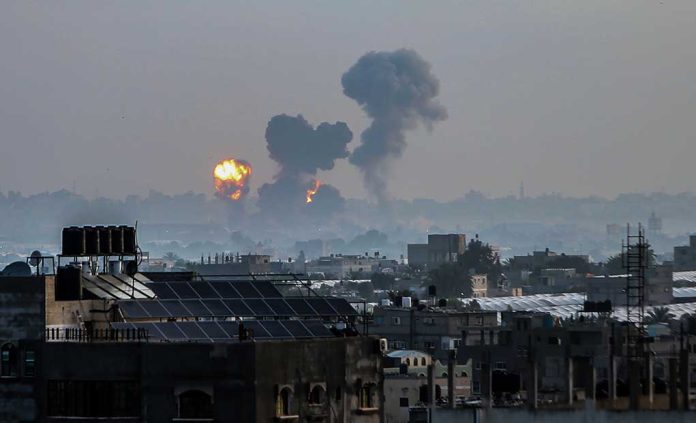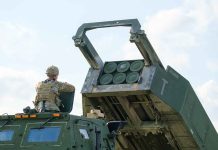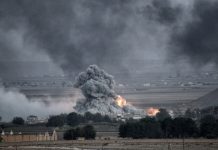
Israel unleashes unprecedented airstrikes on Hezbollah, decimating missile depots and eliminating senior commanders, but experts warn the terror group remains a significant threat.
At a Glance
- Israel conducts extensive airstrikes against Hezbollah in Lebanon, described as the most extensive in its history
- Strikes destroy approximately 400 rocket launchers, 70 weapons depots, and 80 drones
- At least three senior Hezbollah commanders killed, with 16 top leaders assassinated in recent months
- Experts caution that Hezbollah still poses a major threat due to dispersed and hidden weapons stockpiles
- Israel reportedly preparing for potential ground invasion into Lebanon
Israel’s Unprecedented Offensive Against Hezbollah
In a display of military might, Israel has launched a series of extensive airstrikes against the terrorist organization Hezbollah, targeting missile depots, drones, and rocket launchers across Lebanon.
These operations, lasting several days, have been touted as the “most extensive” strikes “ever carried out in its history,” according to Israeli military leaders and regional news outlets. The strategic offensive aims to suppress Hezbollah’s military capabilities and safeguard Israel’s borders, demonstrating the country’s commitment to defending its citizens against ongoing threats.
The Israeli Defense Forces (IDF) have logged close to 3,000 flight hours, utilizing over 250 warplanes to drop around 2,000 munitions across 200 locations. This massive air campaign has resulted in the destruction of approximately 400 medium-range rocket launchers, 70 weapons storage depots, and around 80 drones and cruise missiles. Additionally, the strikes have targeted Hezbollah’s “surveillance equipment, command rooms, and other infrastructure” used to terrorize Israel’s northern border.
https://twitter.com/idf?lang=en
Significant Blow to Hezbollah’s Leadership and Arsenal
The Israeli offensive has dealt a severe blow to Hezbollah’s leadership structure and military capabilities. At least three senior Hezbollah commanders have been eliminated in the recent strikes, with reports indicating that Israel has assassinated 16 of the terror group’s top leaders in recent months. This systematic targeting of Hezbollah’s command structure has undoubtedly disrupted their operational effectiveness and decision-making processes.
Furthermore, Israeli military sources claim that Hezbollah has lost almost half of its medium and long-range missiles, significantly degrading its ability to threaten Israeli population centers. The IDF has also successfully struck around 60 key targets belonging to Hezbollah’s intelligence division, further crippling the terrorist organization’s operational capabilities.
Potential Ground Invasion and Ongoing Threats
Despite the success of the air campaign, Israeli military leadership is not ruling out the possibility of a ground invasion into Lebanon. Lt. Gen. Herzi Halevi, Israel’s military chief of staff, has hinted at this option, stating, “You go in, destroy the enemy there and decisively destroy their infrastructure.” The IDF has already called up two brigades of reserve soldiers and deployed them to the border with Lebanon, signaling its readiness for potential ground operations.
However, experts caution that despite these significant setbacks, Hezbollah still poses a major threat to Israel’s security. David Schenker, the State Department’s former assistant secretary for Near Eastern Affairs, warns that Hezbollah’s weapons are “dispersed and buried,” making them difficult to completely neutralize through airstrikes alone. This reality underscores the complex and ongoing nature of the threat faced by Israel in its northern region.
As Israel continues its efforts to protect its citizens and restore security to its northern border, the international community watches closely. The ongoing conflict serves as a stark reminder of the persistent threats faced by the Jewish state and the lengths to which it must go to ensure its survival in a hostile region.






















